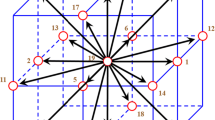Abstract
In numerical simulations of tidal current farms, large-scale computational fluid dynamic (CFD) simulations with a high-resolution grid are required to calculate the interactions between tidal turbines. In this study, we develop a numerical simulation method for tidal current turbines using the lattice Boltzmann method (LBM), which is suitable for large-scale CFD simulations. Tidal turbines are modeled by using the actuator line (ACL) model, which represents each blade as a group of actuator points in a line. In order to validate our LBM-ACL model, we perform simulations for two interacting tidal turbines, and results of turbine performance are compared with a water tank experiment. The proposed model successfully reproduces the variation of the torque due to wave effects and mean turbine performance. We have demonstrated a large-scale simulation for ten tidal turbines using 8.55×108 grid points and 16 GPUs of Tesla P100 and the simulation has been completed within 9 hours with the LBM performance of 392 MLUPS per GPU.
Similar content being viewed by others
References
Mycek P., Gaurier B., Germain G. et al. Experimental study of the turbulence intensity effects on marine current turbines behaviour Part I: One single turbine [J]. Renewable Energy, 2014, 66: 729–746.
Mycek P., Gaurier B., Germain G. et al. Experimental study of the turbulence intensity effects on marine current turbines behaviour Part II: Two interacting turbines [J]. Renewable Energy, 2014, 68: 876–892.
Gaurier B., Carlier C., Germain G. et al. Three tidal turbines in interaction: An experimental study of turbulence intensity effects on wakes and turbine performance [J]. Renewable Energy, 2020, 148: 1150–1164.
Stallard T., Collings R., Feng T. et al. Interactions between tidal turbine wakes: experimental study of a group of three-bladed rotors [J]. Philosophical Transactions of the Royal Society A: Mathematical, Physical and Engineering Sciences, 2013, 371(1985): 20120159.
Nuernberg M., Tao L. Experimental study of wake characteristics in tidal turbine arrays [J]. Renewable Energy, 2020, 127(2018): 168–181.
Sørensen J. N., Shen W. Z. Numerical modeling of wind turbine wakes [J]. Journal of Fluids Engineering, 2002, 124(2): 393–399.
Afgan I., McNaughton J., Rolfo S. et al. Turbulent flow and loading on a tidal stream turbine by LES and RANS [J]. International Journal of Heat and Fluid Flow, 2013, 43: 96–108.
Angelidis D., Chawdhary S., Sotiropoulos F. Unstructured Cartesian refinement with sharp interface immersed boundary method for 3D unsteady incompressible flows [J]. Journal of Computational Physics, 2016, 325: 272–300.
Ouro P., Ramírez L., Harrold M. Analysis of array spacing on tidal stream turbine farm performance using large-eddy simulation [J]. Journal of Fluids and Structures, 2019, 91: 102732.
Wolf-Gladrow D. A. Lattice-gas cellular automata and lattice Boltzmann models: an introduction [M]. Berlin, German: Springer, 2004
Grondeau M., Guillou S. S., Poirier J. C. et al. Studying the wake of a tidal turbine with an IBM-LBM approach using realistic inflow conditions [J]. Energies, 2022, 15: 2092.
Grondeau M., Guillou S. S., Mercier P. et al. Wake of a ducted vertical axis tidal turbine in turbulent flows, LBM actuator-line approach [J]. Energies, 2019, 12: 4273.
Geier M., Schönherr M., Pasquali A. et al. The cumulant lattice Boltzmann equation in three dimensions: Theory and validation [J]. Computers and Mathematics with Applications, 2015, 70(4): 507–547
Hu C., Fukushima S., Kamra M. M. et al. Experimental study of the interaction between two tidal turbines with the free surface wave effect [C]. Conference proceedings of the Japan Society of Naval Architects and Ocean Engineers, 2021, 32: 633–636.
Bhatnagar P. L., Gross E. P., Krook M. A model for collision processes in gases. I. Small amplitude processes in charged and neutral one-component systems [J]. Physical Review, 1954, 94(3): 511–525.
Marten D., Wendler J., Pechlivanoglou G. et al. QBLADE: An open source tool for design and simulation of horizontal and vertical axis wind turbines [J]. International Journal of Emerging Technology and Advanced Engineering, 2013, 3(3): 264–269.
Liu C., Hu C. An actuator line-immersed boundary method for simulation of multiple tidal turbines [J]. Renewable Energy, 2019, 136: 473–490.
Asmuth H., Olivares-Espinosa H., Nilsson K. et al. The actuator line model in lattice Boltzmann frameworks: Numerical sensitivity and computational performance [J]. Journal of Physics: Conference Series, 2019, 1256(1): 012022.
Onodera N., Ohashi K. Large-scale free-surface flow simulation using lattice Boltzmann method on multi-GPU clusters [C]. ECCOMAS Congress 2016-Proceedings of the 7th European Congress on Computational Methods in Applied Sciences and Engineering, Istanbul, Turkey, 2016, 1294–1304.
Janßen C., Krafczyk M. Free surface flow simulations on GPGPUs using the LBM [J]. Computers and Mathematics with Applications, 2011, 61(12): 3549–3563.
Watanabe S., Aoki T. Large-scale flow simulations using lattice Boltzmann method with AMR following free-surface on multiple GPUs [J]. Computer Physics Communications, 2021, 264: 107871.
Watanabe S., Fujisaki S., Hu C. Numerical simulation of dam break flow impact on vertical cylinder by cumulant lattice Boltzmann method [J]. Journal of Hydrodynamics, 2021, 33(2): 185–194.
Asmuth H., Olivares-espinosa H., Ivanell S. Actuator line simulations of wind turbine wakes using the lattice Boltzmann method [J]. Wind Energy Science, 2020, 5(2): 623–645.
Valero-Lara P. Reducing memory requirements for large size LBM simulations on GPUs [J]. Concurrency and Computation: Practice and Experience, 2017, 29(24): e4221.
Acknowledgments
This work was supported by the JSPS KAKENHI (Grant No. JP19H02363). The computation was carried out using the computer resource offered under the category of General Projects by Research Institute for Information Technology, Kyushu University.
Author information
Authors and Affiliations
Corresponding author
Additional information
Biography: Seiya Watanabe (1991-), Male, Ph. D.
Rights and permissions
About this article
Cite this article
Watanabe, S., Hu, C. Lattice Boltzmann simulations for multiple tidal turbines using actuator line model. J Hydrodyn 34, 372–381 (2022). https://doi.org/10.1007/s42241-022-0037-0
Received:
Revised:
Accepted:
Published:
Issue Date:
DOI: https://doi.org/10.1007/s42241-022-0037-0




